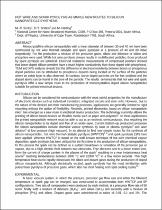 ResearchSpace
ResearchSpace
Hot wire and spark pyrolysis as simple new routes to silicon nanoparticle synthesis
JavaScript is disabled for your browser. Some features of this site may not work without it.
- ResearchSpace
- →
- Research Publications/Outputs
- →
- Conference Publications
- →
- View Item
| dc.contributor.author |
Scriba, Manfred R

|
|
| dc.contributor.author |
Britton, DT

|
|
| dc.contributor.author |
Härting, M

|
|
| dc.date.accessioned | 2013-03-27T10:20:22Z | |
| dc.date.available | 2013-03-27T10:20:22Z | |
| dc.date.issued | 2012-11 | |
| dc.identifier.citation | Scriba, MR, Britton, DT and Härting, M. 2012. Hot wire and spark pyrolysis as simple new routes to silicon nanoparticle synthesis. In: Nanostructured Materials and Nanotechnology VI: A collection of papers presented at the 36th International Conference on Advanced Ceramics and Composites January 22-27, 2012, Daytona Beach, Florida | en_US |
| dc.identifier.isbn | 9781118205976 | |
| dc.identifier.isbn | 9781118217511 | |
| dc.identifier.uri | http://onlinelibrary.wiley.com/doi/10.1002/9781118217511.ch7/summary | |
| dc.identifier.uri | http://hdl.handle.net/10204/6635 | |
| dc.description | Nanostructured Materials and Nanotechnology VI: A collection of papers presented at the 36th International Conference on Advanced Ceramics and Composites January 22-27, 2012, Daytona Beach, Florida. Published by Wiley-Blackwell | en_US |
| dc.description.abstract | Monocrystalline silicon nanoparticles with a mean diameter of between 30 and 40 nm have been synthesised by hot wire thermal catalytic and spark pyrolysis at a pressure of 40 and 80 mbar respectively. For the production a mixture of the precursor gases, silane and diborane or silane and phosphine were used. While hot wire pyrolysis always results in multifaceted particles, those produced by spark pyrolysis are spherical. Electrical resistance measurements of compressed powders showed that boron doped silicon powders have a much higher conductivity than those doped with phosphorus. TEM and XPS analysis reveals that the difference in electrical resistivity between boron an phosphorus doped particles can be attributed to phosphorus dopants being located at the surface of the particles where an oxide layer is also observed. In contrast, boron doped particles are far less oxidised and the dopant atoms can be found in the core of the particle. The results demonstrate that hot wire and spark pyrolysis offer a new simple route to the production of monocrystalline doped silicon nanoparticles suitable for printed electrical devices. | en_US |
| dc.language.iso | en | en_US |
| dc.publisher | Wiley-Blackwell | en_US |
| dc.relation.ispartofseries | Workflow;10353 | |
| dc.subject | Silicon nanoparticles | en_US |
| dc.subject | Nanoparticles | en_US |
| dc.subject | Nanoparticle synthesis | en_US |
| dc.title | Hot wire and spark pyrolysis as simple new routes to silicon nanoparticle synthesis | en_US |
| dc.type | Conference Presentation | en_US |
| dc.identifier.apacitation | Scriba, M. R., Britton, D., & Härting, M. (2012). Hot wire and spark pyrolysis as simple new routes to silicon nanoparticle synthesis. Wiley-Blackwell. http://hdl.handle.net/10204/6635 | en_ZA |
| dc.identifier.chicagocitation | Scriba, Manfred R, DT Britton, and M Härting. "Hot wire and spark pyrolysis as simple new routes to silicon nanoparticle synthesis." (2012): http://hdl.handle.net/10204/6635 | en_ZA |
| dc.identifier.vancouvercitation | Scriba MR, Britton D, Härting M, Hot wire and spark pyrolysis as simple new routes to silicon nanoparticle synthesis; Wiley-Blackwell; 2012. http://hdl.handle.net/10204/6635 . | en_ZA |
| dc.identifier.ris | TY - Conference Presentation AU - Scriba, Manfred R AU - Britton, DT AU - Härting, M AB - Monocrystalline silicon nanoparticles with a mean diameter of between 30 and 40 nm have been synthesised by hot wire thermal catalytic and spark pyrolysis at a pressure of 40 and 80 mbar respectively. For the production a mixture of the precursor gases, silane and diborane or silane and phosphine were used. While hot wire pyrolysis always results in multifaceted particles, those produced by spark pyrolysis are spherical. Electrical resistance measurements of compressed powders showed that boron doped silicon powders have a much higher conductivity than those doped with phosphorus. TEM and XPS analysis reveals that the difference in electrical resistivity between boron an phosphorus doped particles can be attributed to phosphorus dopants being located at the surface of the particles where an oxide layer is also observed. In contrast, boron doped particles are far less oxidised and the dopant atoms can be found in the core of the particle. The results demonstrate that hot wire and spark pyrolysis offer a new simple route to the production of monocrystalline doped silicon nanoparticles suitable for printed electrical devices. DA - 2012-11 DB - ResearchSpace DP - CSIR KW - Silicon nanoparticles KW - Nanoparticles KW - Nanoparticle synthesis LK - https://researchspace.csir.co.za PY - 2012 SM - 9781118205976 SM - 9781118217511 T1 - Hot wire and spark pyrolysis as simple new routes to silicon nanoparticle synthesis TI - Hot wire and spark pyrolysis as simple new routes to silicon nanoparticle synthesis UR - http://hdl.handle.net/10204/6635 ER - | en_ZA |





